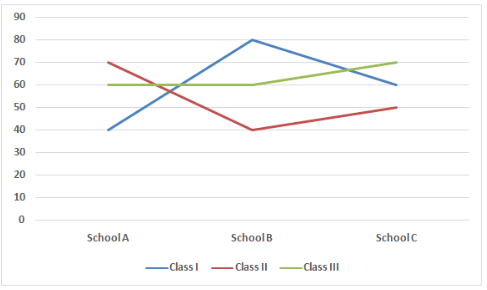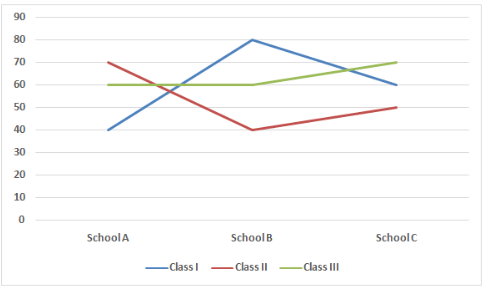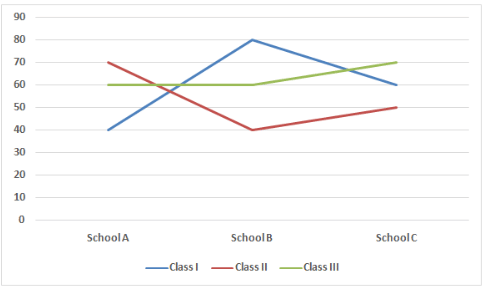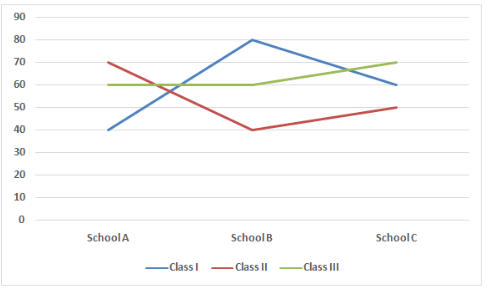Goa PCS Pre-Screening Mock Test- 9 - GPSC (Goa) MCQ
30 Questions MCQ Test - Goa PCS Pre-Screening Mock Test- 9
Directions : Read the following information carefully to answer the questions given below.
Ten persons are sitting in two parallel rows containing five persons each. In row 1, L, M, N, O and P are sitting and all of them are facing south. In row 2, A, B, C, D and E are sitting and all of them are facing north. In the given seating arrangement, each member seated in a row faces another member of the other row. Each of them likes different colours-Pink, Blue, Red, Black, Green, Yellow, Grey, Purple, cyan and Brown but not necessarily in the same order.
L sits one of the end of the row. P sits third to the right of M and one of them sits at the end of the row. The immediate neighbour of P faces the one who likes Grey colour. C does not face the one who likes Black colour. O likes Green colour and faces the one who likes Cyan colour. E, sits 2nd to the right of the one who likes Yellow. L, likes Blue colour and his immediate neighbour faces the one who likes Yellow colour. O faces the one who sits third to the right A. D sits third to the left of the one who likes Brown colour. N likes Black colour. Two persons sits between the one who likes Pink and the one who likes Purple colour. D does not face the one who likes Purple colour. B does not like Red colour.
Q. Who among the following likes Purple colour?
Ten persons are sitting in two parallel rows containing five persons each. In row 1, L, M, N, O and P are sitting and all of them are facing south. In row 2, A, B, C, D and E are sitting and all of them are facing north. In the given seating arrangement, each member seated in a row faces another member of the other row. Each of them likes different colours-Pink, Blue, Red, Black, Green, Yellow, Grey, Purple, cyan and Brown but not necessarily in the same order.
L sits one of the end of the row. P sits third to the right of M and one of them sits at the end of the row. The immediate neighbour of P faces the one who likes Grey colour. C does not face the one who likes Black colour. O likes Green colour and faces the one who likes Cyan colour. E, sits 2nd to the right of the one who likes Yellow. L, likes Blue colour and his immediate neighbour faces the one who likes Yellow colour. O faces the one who sits third to the right A. D sits third to the left of the one who likes Brown colour. N likes Black colour. Two persons sits between the one who likes Pink and the one who likes Purple colour. D does not face the one who likes Purple colour. B does not like Red colour.
Q. Who among the following likes Purple colour?
Directions : Read the following information carefully to answer the questions given below.
Ten persons are sitting in two parallel rows containing five persons each. In row 1, L, M, N, O and P are sitting and all of them are facing south. In row 2, A, B, C, D and E are sitting and all of them are facing north. In the given seating arrangement, each member seated in a row faces another member of the other row. Each of them likes different colours-Pink, Blue, Red, Black, Green, Yellow, Grey, Purple, cyan and Brown but not necessarily in the same order.
L sits one of the end of the row. P sits third to the right of M and one of them sits at the end of the row. The immediate neighbour of P faces the one who likes Grey colour. C does not face the one who likes Black colour. O likes Green colour and faces the one who likes Cyan colour. E, sits 2nd to the right of the one who likes Yellow. L, likes Blue colour and his immediate neighbour faces the one who likes Yellow colour. O faces the one who sits third to the right A. D sits third to the left of the one who likes Brown colour. N likes Black colour. Two persons sits between the one who likes Pink and the one who likes Purple colour. D does not face the one who likes Purple colour. B does not like Red colour.
Q. Which of the following colour does B like?
L sits one of the end of the row. P sits third to the right of M and one of them sits at the end of the row. The immediate neighbour of P faces the one who likes Grey colour. C does not face the one who likes Black colour. O likes Green colour and faces the one who likes Cyan colour. E, sits 2nd to the right of the one who likes Yellow. L, likes Blue colour and his immediate neighbour faces the one who likes Yellow colour. O faces the one who sits third to the right A. D sits third to the left of the one who likes Brown colour. N likes Black colour. Two persons sits between the one who likes Pink and the one who likes Purple colour. D does not face the one who likes Purple colour. B does not like Red colour.
Directions : Read the following information carefully to answer the questions given below.
Ten persons are sitting in two parallel rows containing five persons each. In row 1, L, M, N, O and P are sitting and all of them are facing south. In row 2, A, B, C, D and E are sitting and all of them are facing north. In the given seating arrangement, each member seated in a row faces another member of the other row. Each of them likes different colours-Pink, Blue, Red, Black, Green, Yellow, Grey, Purple, cyan and Brown but not necessarily in the same order.
L sits one of the end of the row. P sits third to the right of M and one of them sits at the end of the row. The immediate neighbour of P faces the one who likes Grey colour. C does not face the one who likes Black colour. O likes Green colour and faces the one who likes Cyan colour. E, sits 2nd to the right of the one who likes Yellow. L, likes Blue colour and his immediate neighbour faces the one who likes Yellow colour. O faces the one who sits third to the right A. D sits third to the left of the one who likes Brown colour. N likes Black colour. Two persons sits between the one who likes Pink and the one who likes Purple colour. D does not face the one who likes Purple colour. B does not like Red colour.
Q. If L related to D in the same way N related to E then following the same pattern P is related to?
L sits one of the end of the row. P sits third to the right of M and one of them sits at the end of the row. The immediate neighbour of P faces the one who likes Grey colour. C does not face the one who likes Black colour. O likes Green colour and faces the one who likes Cyan colour. E, sits 2nd to the right of the one who likes Yellow. L, likes Blue colour and his immediate neighbour faces the one who likes Yellow colour. O faces the one who sits third to the right A. D sits third to the left of the one who likes Brown colour. N likes Black colour. Two persons sits between the one who likes Pink and the one who likes Purple colour. D does not face the one who likes Purple colour. B does not like Red colour.
Directions : Read the following information carefully to answer the questions given below.
Ten persons are sitting in two parallel rows containing five persons each. In row 1, L, M, N, O and P are sitting and all of them are facing south. In row 2, A, B, C, D and E are sitting and all of them are facing north. In the given seating arrangement, each member seated in a row faces another member of the other row. Each of them likes different colours-Pink, Blue, Red, Black, Green, Yellow, Grey, Purple, cyan and Brown but not necessarily in the same order.
L sits one of the end of the row. P sits third to the right of M and one of them sits at the end of the row. The immediate neighbour of P faces the one who likes Grey colour. C does not face the one who likes Black colour. O likes Green colour and faces the one who likes Cyan colour. E, sits 2nd to the right of the one who likes Yellow. L, likes Blue colour and his immediate neighbour faces the one who likes Yellow colour. O faces the one who sits third to the right A. D sits third to the left of the one who likes Brown colour. N likes Black colour. Two persons sits between the one who likes Pink and the one who likes Purple colour. D does not face the one who likes Purple colour. B does not like Red colour.
Q. Who among the following sits opposite to D?
Directions : Read the following information carefully to answer the questions given below.
Ten persons are sitting in two parallel rows containing five persons each. In row 1, L, M, N, O and P are sitting and all of them are facing south. In row 2, A, B, C, D and E are sitting and all of them are facing north. In the given seating arrangement, each member seated in a row faces another member of the other row. Each of them likes different colours-Pink, Blue, Red, Black, Green, Yellow, Grey, Purple, cyan and Brown but not necessarily in the same order.
L sits one of the end of the row. P sits third to the right of M and one of them sits at the end of the row. The immediate neighbour of P faces the one who likes Grey colour. C does not face the one who likes Black colour. O likes Green colour and faces the one who likes Cyan colour. E, sits 2nd to the right of the one who likes Yellow. L, likes Blue colour and his immediate neighbour faces the one who likes Yellow colour. O faces the one who sits third to the right A. D sits third to the left of the one who likes Brown colour. N likes Black colour. Two persons sits between the one who likes Pink and the one who likes Purple colour. D does not face the one who likes Purple colour. B does not like Red colour.
Q. Who among the following likes Red colour?
Directions : In each of the question below is given three or four statements followed by three or four conclusions. You have to take the given statements to be true even if they seem to be at variance from commonly known facts. Read all the conclusions and then decide which of the given conclusions logically follow from the given statements disregarding commonly known facts.
Statements:
Some Blue are Red.
Some Red are Black.
No Black are grey.
Conclusions:
I. Some Blue are not Grey.
II. All Red being grey is a possibility.
III. All Grey can be Red.
Directions : In each of the question below is given three or four statements followed by three or four conclusions. You have to take the given statements to be true even if they seem to be at variance from commonly known facts. Read all the conclusions and then decide which of the given conclusions logically follow from the given statements disregarding commonly known facts.
Statements:
ALL Book is copy.
No Copy is Pen.
Some Pen are Refill.
Conclusions:
I. Some Book are not Refill.
II. At least some copy are pen.
III. All Refill being book is a possibility.
Directions : In each of the question below is given three or four statements followed by three or four conclusions. You have to take the given statements to be true even if they seem to be at variance from commonly known facts. Read all the conclusions and then decide which of the given conclusions logically follow from the given statements disregarding commonly known facts.
Statements:
Some pdf are docs.
No docs is a folder.
Some folder are file.
Conclusions:
I. At least some Pdf are not Folder.
II. Some Folder are not Pdf.
III. Some file are not Docs.
Directions : In each of the question below is given three or four statements followed by three or four conclusions. You have to take the given statements to be true even if they seem to be at variance from commonly known facts. Read all the conclusions and then decide which of the given conclusions logically follow from the given statements disregarding commonly known facts.
Q. Statements:
All Bread are butter.
All Butter are Yellow.
No Pink is Yellow.
Some Yellow are Black.
Conclusions
I. No black is pink.
II. Some Black are bread.
III. No black are bread.
Directions : In each of the question below is given three or four statements followed by three or four conclusions. You have to take the given statements to be true even if they seem to be at variance from commonly known facts. Read all the conclusions and then decide which of the given conclusions logically follow from the given statements disregarding commonly known facts.
Statements:
All Truth are lie.
No lie are word.
Some words are File.
No file is Folder.
Conclusion:
I. No word is Truth.
II. Some word are not folder.
III. All File are Lies.
IV. No Folder are Truth.
Directions : In these questions relationship between different elements is shown in the statements. The statements are followed by conclusions. Study the conclusions based on the given statement and select the appropriate answer.
Statements:
A < D = M ≥ R; S ≥ M ≥ N
Conclusions:
I. R < S
II. R = S
Directions : In these questions relationship between different elements is shown in the statements. The statements are followed by conclusions. Study the conclusions based on the given statement and select the appropriate answer.
Statements:
E > Z = U ≥ T; Y > U ≥ X
Conclusions:
I. E > Y
II. E > X
Directions : In these questions relationship between different elements is shown in the statements. The statements are followed by conclusions. Study the conclusions based on the given statement and select the appropriate answer.
Statements:
A ≥ B ≤ C = T, A < L ≥ V
Conclusions:
I. V ≤ C
II. C > V
Directions : In these questions relationship between different elements is shown in the statements. The statements are followed by conclusions. Study the conclusions based on the given statement and select the appropriate answer.
Statements:
D < E ≤ C; A > D; B ≥ C
Conclusions:
I. B > D
II. A ≥ C
Directions : In these questions relationship between different elements is shown in the statements. The statements are followed by conclusions. Study the conclusions based on the given statement and select the appropriate answer.
Statements:
D > E ≥ C; A > D; B ≥ C
Conclusions:
I. A > C
II. E < A
Directions : Study the following information to answer the given questions
In a certain code
'fight kick up wrestle' is written as 'lp pk ks st',
'shin kick up knee' is written as 'ir ks fu lp'.
'wrestle elbow shin jab' is written as 'gt ir gb pk'
'up armbar elbow choke' is written as 'gt xz lo ks'
Q. What is the code for 'armbar'?
Directions : Study the following information to answer the given questions
In a certain code
'fight kick up wrestle' is written as 'lp pk ks st',
'shin kick up knee' is written as 'ir ks fu lp'.
'wrestle elbow shin jab' is written as 'gt ir gb pk'
'up armbar elbow choke' is written as 'gt xz lo ks'
Q. Which of the following may represent 'knee is kick'?
Directions : Study the following information to answer the given questions
In a certain code
'fight kick up wrestle' is written as 'lp pk ks st',
'shin kick up knee' is written as 'ir ks fu lp'.
'wrestle elbow shin jab' is written as 'gt ir gb pk'
'up armbar elbow choke' is written as 'gt xz lo ks'
Q. ‘pk’ is the code for
Directions : Study the following information to answer the given questions
In a certain code
'fight kick up wrestle' is written as 'lp pk ks st',
'shin kick up knee' is written as 'ir ks fu lp'.
'wrestle elbow shin jab' is written as 'gt ir gb pk'
'up armbar elbow choke' is written as 'gt xz lo ks'
Q. What is the code for' fight'?
Directions : Study the following information to answer the given questions
In a certain code
'fight kick up wrestle' is written as 'lp pk ks st',
'shin kick up knee' is written as 'ir ks fu lp'.
'wrestle elbow shin jab' is written as 'gt ir gb pk'
'up armbar elbow choke' is written as 'gt xz lo ks'
Q. Which of the following represents 'elbow shin kick'?
Directions : Study the following information carefully to answer these questions.
(i) ‘M $ N’ means’ M is mother of N’.
(ii) ‘M # N’ means’ M is father of N’.
(iii) ‘M @ N’ means’ M is husband of N’.
(iv) ‘M % N’ means ‘M is daughter of N’.
Q. If N@Q$M#T, then how is N related to T?
Directions : Study the following information carefully to answer these questions.
(i) ‘M $ N’ means’ M is mother of N’.
(ii) ‘M # N’ means’ M is father of N’.
(iii) ‘M @ N’ means’ M is husband of N’.
(iv) ‘M % N’ means ‘M is daughter of N’.
Q. Which of the following expressions shows ‘S is the sister of H?
Directions : Study the following information carefully to answer these questions.
(i) ‘M $ N’ means’ M is mother of N’.
(ii) ‘M # N’ means’ M is father of N’.
(iii) ‘M @ N’ means’ M is husband of N’.
(iv) ‘M % N’ means ‘M is daughter of N’.
Q. If F @ D % K # I, then how is F related to I?
In a class of 36 students P’s rank from the top is 12. Z ranks three places above P. What is Z rank from bottom?
Ravi started from his house towards North. After covering a distance of 8 km, he turned towards left and covered a distance of 6 km. What is the shortest distance now from his house?
7 years ago, the ratio of the ages of Mohit and Rohit was 12:13. 14 years so, the ratio of their ages will be 19:20. Find the sum of the present ages of Mohit and Rohit?
Study the following information carefully and answer the questions given below.
The given below line graph shows the total number of students studying in three different schools [A, B and C] and each school consists of three classes [I, II and III].

Q. In another school D, Number of students in class I is 20% more than the number of students in class I of school A and number of students in class II is 15 more than the number of students in class II of school B. If total number of students in school D is 135, then find the number students in class III of school D.
Study the following information carefully and answer the questions given below.
The given below line graph shows the total number of students studying in three different schools [A, B and C] and each school consists of three classes [I, II and III].

Q. If total number of students in three classes of school F are equal to the total number of students in class III of schools A, B and C together. If class I and class II students in school F are the same as class I and class II students of school C, then find the number of students in class III of school F?
Study the following information carefully and answer the questions given below.
The given below line graph shows the total number of students studying in three different schools [A, B and C] and each school consists of three classes [I, II and III].

Q. Ratio of the number of students in class I of school C to school E is 3:2 and number of students in class II and class III of school E is 20% and 25% more than the number of students of class I in the same school respectively. Find the total number of students in school E.
Study the following information carefully and answer the questions given below.
The given below line graph shows the total number of students studying in three different schools [A, B and C] and each school consists of three classes [I, II and III].

Q. Find the ratio between the total number of students in class I of all the given schools together and the total number of students in class II of all the given schools together.














